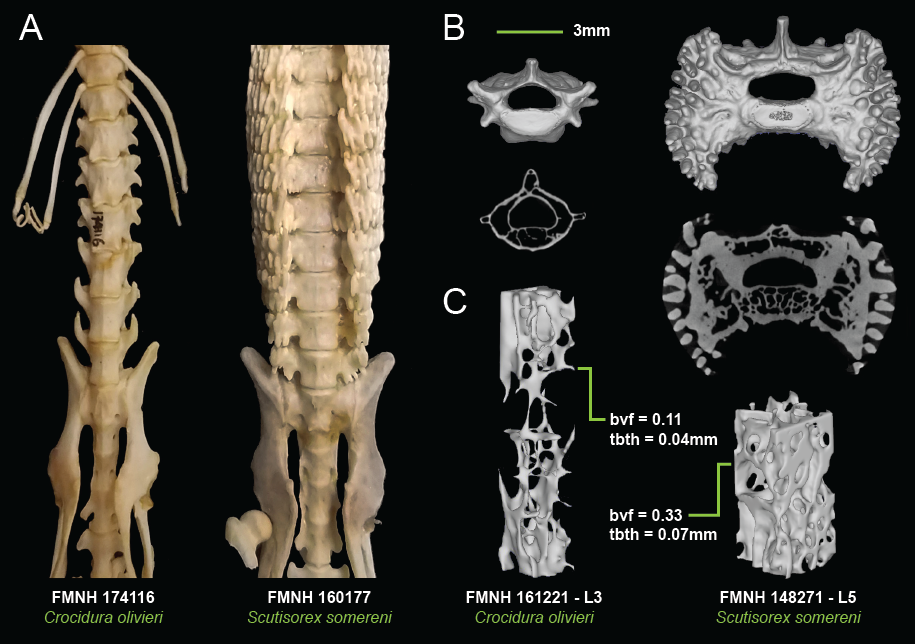Deciphering the weird: SCUTISOREX
how do internal (trabecular) bone and external (cortical) bone tissues function together in mammalian systems to produce whole-bone and multi-bone functional properties?
A, comparison, to scale, between lumbar spines of the hero shrew Scutisorex (on right) and a shrew of similar size, Crocidura olivieri, on left. B, anterior view of a single midcolumn lumbar vertebra from both C. olivieri and S. somereni, with CT slice below showing trabeculae in centrum. Scale bar = 3mm. C, prisms of trabecular bone from centra of each vertebra shown above, with cranial towards the top; differences in bone volume fraction (bvf, a measure of density) and trabecular thickness (tbth) between the species are clear.
As a National Science Foundation Postdoctoral Fellow in Biological Collections at the Field Museum of Natural History, I investigated the functional morphology of trabecular bone in the lumbar spine of the African hero shrew Scutisorex. This work was executed in collaboration with Ken Angielczyk, Lawrence Heaney, and Julian Kerbis Peterhans (Field Museum. The hero shrew has a spine that is unique among mammals, with almost twice as many lumbar vertebrae as close relatives and numerous peglike accessory articulations protruding from its vertebrae. The function of this strange morphology is historically enigmatic, because it is hard to compare to other structures with known functions.
To circumvent this issue, we inspected the internal trabecular (spongy) bone of Scutisorex vertebrae, and compared it to that of “normal” shrews. Trabecular bone adapts to forces it experiences during an animal’s lifetime, and is therefore a useful tool for understanding function in hard-to-study species and structures. We found not only that Scutisorex has more robust spongy bone than other shrews, but also that its spine has different morphological regions than other shrews. Does this relate to its unique function? Yes! The robust bone suggests that the Scutisorex spine than bear higher compressive loads than other shrews, and the additional morphological regions in the spine may hold clues about how the animal is holding its body during possible high-stress behaviors. Research in this area is ongoing - look out for updates in 2023!
Publications
Smith, S.M., Angielczyk, K.D. 2022. A shrewd inspection of vertebral regionalization in large shrews (Soricidae: Crocidurinae). Integrative Organismal Biology 4: 1-17. doi: 10.1093/iob/obac006
Smith, S.M., Angielczyk, K.D. Deciphering an extreme morphology: bone microarchitecture of the hero shrew backbone (Soricidae: Scutisorex). Proceedings of the Royal Society B: Biological Sciences 287: 20200457. doi: 10.1098/rspb.2020.0457.
NSF Postdoctoral Research Fellowship in Biology FY 2018: Abstract.
Media coverage
National Geographic, Smithsonian Magazine, Science News, CNN
